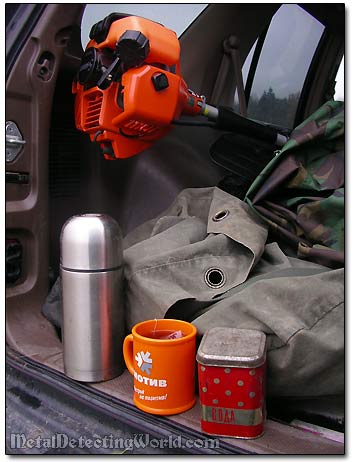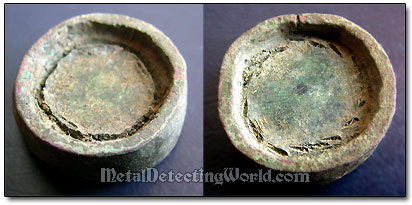Part I - Metal Detecting at the Swedish Tavern Site, page 37
Recovering Lead Merchant and Brass Trade Weights
...After digging up a few more brass casings and large fragments of the iron artillery projectiles, I came to a conclusion: there were no old coins under the WW2 layer at this spot. At this moment, I had only one thought in my mind, "Enough of digging the war for me!" Before moving to a different spot to search for coins, I needed to collect my thoughts and summon up my strength - it was time for taking a tea break!

While relaxing with a cup of green tea and a cigarette, I was thinking about the options I had now. Nikolai and I had already covered 90% of the site. Only the tough spots - patches of thick grass, had been left undetected. We had a weed-whacker with us, which could easily take care of the remaining thick grass, but we did not have much daylight left, and the cold breath of upcoming winter was getting stronger - we were limited with time.
We decided not to bother with the tough spots - they could wait until next spring, and the grass was going to be flattened by the snow anyway. The only available spot that I had not detected yet was a plat - the "railroad side" of the triangle, where Nikolai found the silver signet ring. That was where I headed.
The first non-ferrous signal I located was given by an unmarked lead weight. It had an unusual design of a circular shape: 25mm in diameter and 12mm thick, with eight round indentations equally notched on the outside circumference, with a 11mm-diameter hole through, and a groove on the circumference inside the hole.
In the past, although official lead weights were available, many traders and merchants made and used their own and illegal weights. Usage of unofficial weights (not weighing the exact standards) reflects the buyers's concern about regular consistency rather than the weight of the goods in kilograms, pounds or ounces. of the produce
Lead has a low melting point and is soft, pliable, and easy to cast, so no special equipment was required for the weights manufacture. Once in the ground, lead develops a white surface oxidation, but does not suffer very much from soil acids.
Unofficial Lead Weight of Trader or Merchant

If the weight does not carry any official mark, it is hard to accurately date it unless the weight can be associated with finds from an excavation. The holes through these weights can be explained by two reasons: 1) the holes allow a whole set of weights to be threaded with a thong for transportation and 2) a single weight can be hung on a thick thong or thin rope of an arm length to be used as a swinging weapon like a medieval flail to calm down an enraged customer. This relic could also be a "loom weight" or net weight used by country folk or poachers to catch a small game or birds.
I also found a trade weight made of brass or copper alloy. It had a diameter of 23mm (15/16") and was 7.5mm thick. Except a circular groove notched on the obverse and circular broken line notched on reverse, this trade weight did not bear any heraldic design, symbols, inscription or abbreviation that could be related to the ruler. Most likely this was an unofficial trade weight made by the local trader or merchant according to the local standards of the time.
Unofficial Brass Trade or Coin Weight, ca. 17th-18th Century

I believe I correctly identified this relic as a trade weight by its characteristic design which would allow to make an orderly pile of a few weights of different diameters that fitted inside each other. Besides, it resembled the trade weight I dug up in Wyltshire, England, a few years ago.
Marked Bronze Trade Weight I Dug Up in England
